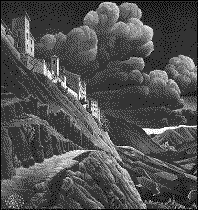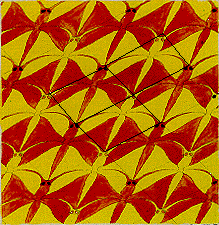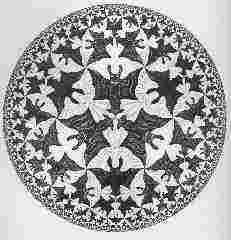Or search by topic
Number and algebra
Geometry and measure
Probability and statistics
Working mathematically
Advanced mathematics
For younger learners
Published 2011 Revised 2018
Maurits Cornelius Escher
Have you ever noticed how mathematical ideas are often used in patterns that we see all around us? Sometimes it is hard to decide when maths becomes art, or vice-versa.
One artist who may have agre ed with this is Maurits Cornelius Escher. He was born in 1898, in the Netherlands, and showed great artistic talent from an early age. At first Escher concentrated on sketching scenery and things around him. However, on a visit
to Alhambra in Spain, he became fascinated by the Arabic tessellating patterns contained in the tiles, and started to experiment more with shapes and mirror images. In the late 1920s people began to recognise his style.
ed with this is Maurits Cornelius Escher. He was born in 1898, in the Netherlands, and showed great artistic talent from an early age. At first Escher concentrated on sketching scenery and things around him. However, on a visit
to Alhambra in Spain, he became fascinated by the Arabic tessellating patterns contained in the tiles, and started to experiment more with shapes and mirror images. In the late 1920s people began to recognise his style.
This is called "Castrovalva", a mountainside village, and was finished in 1930
All M.C. Escher works (c) 2001
Cordon Art - Baarn - Holland.
All rights reserved. Used by permission .

All M.C. Escher works (c) 2001 Cordon Art - Baarn - Holland. All rights reserved. Used by permission.
This picture was completed in 1930 and is called "Day and Night". Can you see how Escher has used black and white bird silhouettes to show the change from day to night?
In 1936, Escher made a second trip to Alhambra. After this, his pictures  c
c
ontained more shapes, which were often transformed by reflections, rotations and translations. This produced amazing tessellations.
Can you see the butterfly motifs here?
This picture is made up of identical parallelograms which have been shifted diagonally.
All M.C. Escher works (c) 2001 Cordon Art - Baarn - Holland. All rights reserved. Used by permission.

Look at these parrots.
Can you work out how they have been moved to make this pattern?
Escher's popularity in America was increasing and he was now in demand as a lecturer in art, maths and sciences. Mathematicians had been admiring his work since the early 40s and their numbers were growing.
Escher's drawings began to show a new theme towards the late 1950s. He perfected a technique known as "showing infinity" which gave the impression that his sketches were endless. He did this by making the objects gradually smaller towards the edge of the paper. Have a look!

This is called "Circle Limit IV" and was finished in 1960.
Unfortunately, Escher became quite ill, although he did see his first book of prints published which gained him even greater recognition. He died in March 1972.
So, what do you think?
Was Escher an artist or a mathematician?
Discuss it with your friends!
You can find out more about this fascinating man from these websites:
All M.C. Escher works (c) 2001 Cordon Art - Baarn - Holland. All rights reserved. Used by permission .
You may also like
Penta Place
Penta people, the Pentominoes, always build their houses from five square rooms. I wonder how many different Penta homes you can create?
Tessellating Triangles
Can you make these equilateral triangles fit together to cover the paper without any gaps between them? Can you tessellate isosceles triangles?

